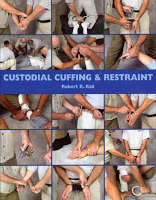“Custodial Cuffing & Restraint” by Robert R. Rail, 2006. 56 pages, 8 1/2″ X 11″, 66 photos.
Applying custodial handcuffs and restraints is a vital skill, and an inherently complex and dangerous task for law enforcement officers, yet scant little has been written about how to properly apply these devices. Custodial Cuffing & Restraint goes beyond just simple instructions.
The techniques described and depicted in this book blend restraint equipment with reactive, bio-mechanical techniques that will enable you to safely and effectively control a subject. These step-by-step instructions provide you with a controlled alternative to force beyond need. They enable you to humanely restrain compliant, resistant, and even combative subjects using the least amount of force needed to achieve compliance.
Custodial Cuffing & Restraint combines the twin goals of officer safety and arrestee welfare in a quick and efficient method. They are realistic and practical restraint techniques that do not sacrifice effectiveness and officer safety for liability protection.
This book begins with the fundamental techniques for restraining a non-resistant subject; probably the most common restraint situation. But at any stage of the restraint procedure, a subject may choose to resist or even attempt to attack you. There are several specific examples of when and how a subject may choose to resist or attack and detailed instructions about how you can quickly and effectively defeat subject resistance without the use of excessive force which would endanger you and the subject, and increase your potential legal liability.
The most important part of law enforcement is officer safety and the most important part of officer safety is consistent and proper training! From the very beginnings of policing through the complexities of our modern times, training has been an integral part of law enforcement. The old adage of “how we train is how we will react” is true. The proper application of restraints is more than just getting the equipment on a subject; you must also consider the bio-mechanical limits of the offender and the “rules” that govern the use of force. Therefore, Custodial Cuffing & Restraint includes two essential chapters – CAUTIONS and USE OF FORCE – which will guide you in your training and in the safe application of restraint devices.
Applying restraints to any subject can be dangerous. You never know when a seemingly compliant subject will suddenly turn resistant or even combative. Included in this book is a section titled THE ATTITUDE OF CONFRONTATION which will give you some insight into how body language can tip you off to a subject’s intentions. Being able to read a person’s body language will help you in any situation in which you are dealing one on one with another individual.
TABLE OF CONTENTS
Warning & Disclaimer
Dedication
Acknowledgements
Introduction
Cautions & Safeguards
Use Of Force
The Attitude of Confrontation
The Blue Box
Cooperative Subject Handcuffing Procedures
Cooperative Subject Waist Chain Securing Procedures
Cooperative Subject Leg Cuffing Procedures
Resistant Subject Supine Detention Control Procedures
Resistant Subject Handcuffing Procedures
Resistant Subject Waist Chain Securing Procedures
Resistant Subject Leg Cuffing Procedures
Available at Handcuff Warehouse: http://www.handcuffwarehouse.com/cucure.html
